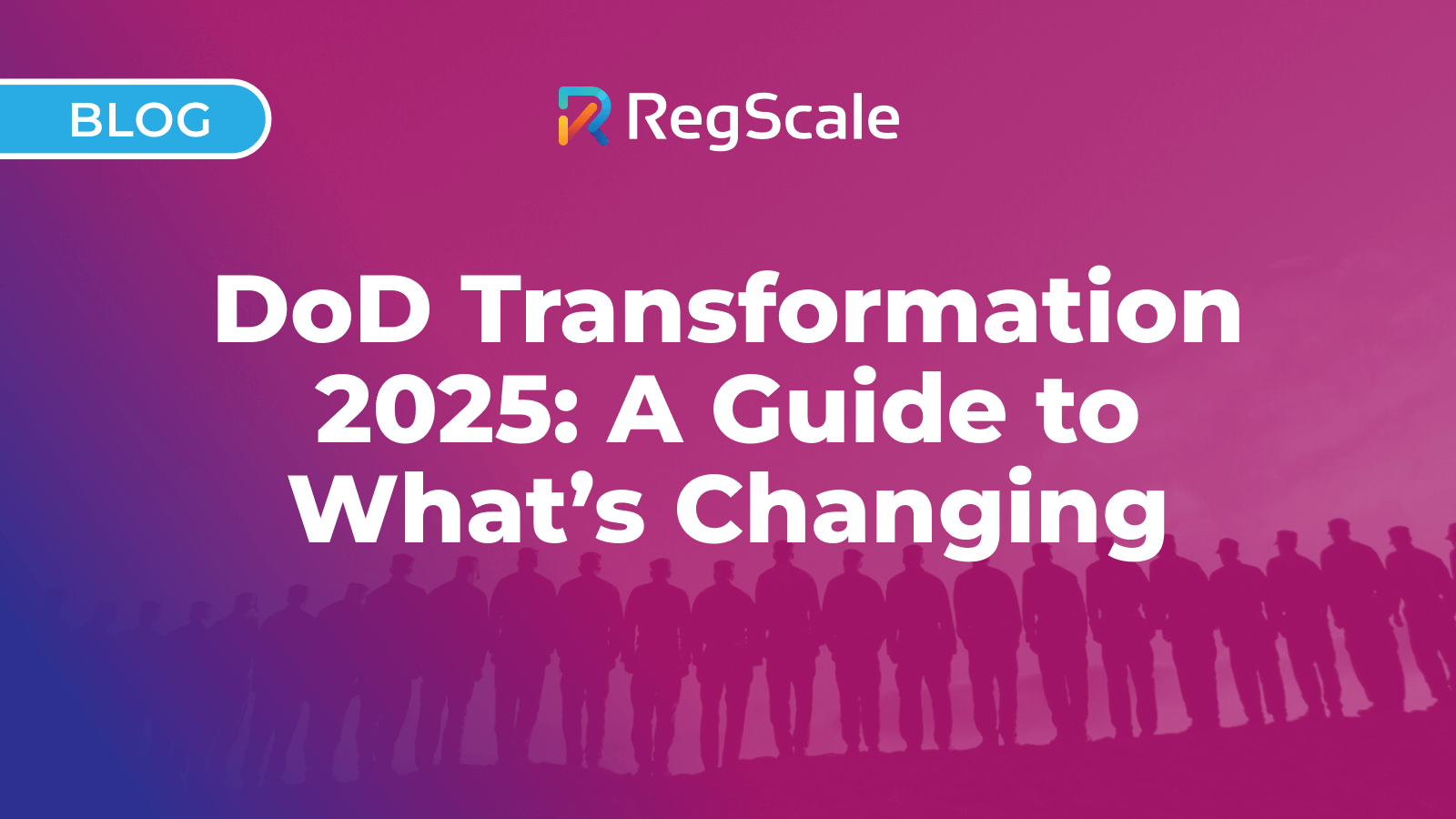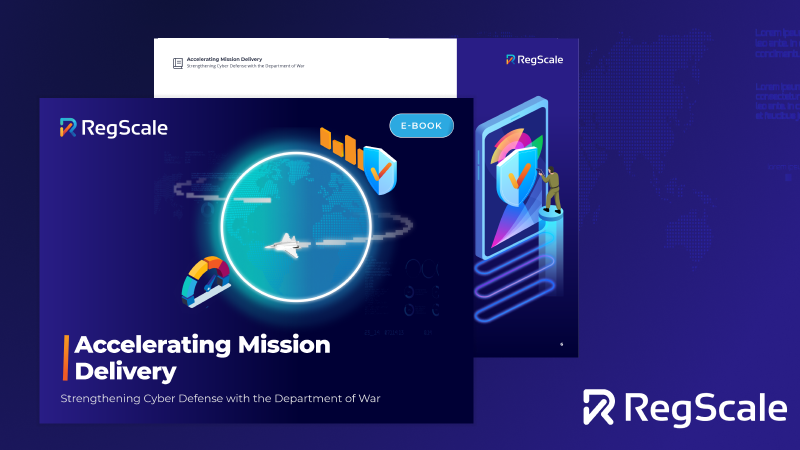DoD Transformation 2025: A Guide to What’s Changing

The US Department of Defense is undergoing one of its most significant transformations in decades. From sweeping budget reallocations to technology modernization, 2025 has already become a pivotal year that will reshape how the DoD operates for years to come.
If you’re working in government compliance, you’ve probably felt the ground shifting beneath your feet. New memos are dropping regularly, acquisition pathways are being overhauled, and technology priorities are evolving at breakneck speed. The question isn’t whether change is coming; it’s how to navigate that change successfully.
Based on our conversations at events like AFCEA West and TechNet Cyber 2025, market research from our partners at Carahsoft, and our ongoing discussions with the federal compliance community, we’ve compiled this guide. It will help you understand what’s changing, why it matters, and how to position your organization for success in this new landscape.
Let’s dive into what 2025 has in store for DoD transformation.
What’s changing in the DoD? Here’s an overview.
The Department of Defense is reshaping how it approaches everything from software acquisition to national security priorities with a series of high-impact memos and executive orders. Here’s a summary of the key changes.
Software acquisition gets a speed boost.
Secretary of Defense Pete Hegseth’s March memo, Directing Modern Software Acquisition to Maximize Lethality, marks a decisive shift toward faster, more agile procurement. The Software Acquisition Pathway (SWP) is now the preferred route for all software development, with Commercial Solutions Openings (CSOs) and Other Transaction Authorities (OTAs) becoming the default approaches rather than traditional contracting methods. This isn’t just bureaucratic shuffling; it’s a way to enable faster software updates and iteration in order to speed service delivery.
Acquisition reform spreads across the DoD
On April 9, the Executive Order Modernizing Defense Acquisitions and Spurring Innovation in the Defense Industrial Base took the transformation even further. This memo extends the preference for CSOs, OTAs, and Rapid Capabilities Offices to all DoD acquisitions, not just software. The order also implements aggressive regulatory reduction, applying a “ten-for-one” rule to cut acquisition policies, and mandates performance metrics for staff using these new pathways. Perhaps most significantly, the DoD must complete a Major Defense Acquisition Program Review by mid-August, identifying any programs that are 15% behind schedule, 15% over budget, or otherwise misaligned with priorities.
Strategic priorities shift to the Indo-Pacific.
The March 2025 memo on Interim National Defense Strategic Guidance also represents a major strategic realignment. The focus is on preventing a Chinese invasion of Taiwan in 2027 and on directing resources toward the Indo-Pacific theater. The guidance also shifts counterterrorism efforts toward credible threats while “deprioritizing” regional terrorist threats in the Middle East and Africa. Meanwhile, new emphasis on using the military for border operations and maintaining access to the Panama Canal signals an upcoming shift in funding and resources.
CMMC implementation ramps up.
The Cybersecurity Maturity Model Certification (CMMC) is also undergoing significant evolution. Originally launched in 2020 with a complex five-level certification system, CMMC 2.0 streamlines the framework into three more manageable tiers aligned with existing standards like NIST SP 800-171. This simplification addresses years of industry feedback while maintaining robust protection for Federal Contract Information and Controlled Unclassified Information across the defense industrial base. The implementation timeline is already underway, with the DoD incorporating CMMC 2.0 requirements into contracts through a phased approach beginning in Q2 2025.
Cybersecurity goes on the offense.
Finally, the administration’s updated approach to cybersecurity marks a philosophical shift from the defensive to the offensive. While China and Iran remain high-priority threats, Russia has notably been deprioritized. There is also increased focus on AI-based threat detection, automated security protocols, and “secure by design” principles, with policies around critical infrastructure security and supply chain resilience currently under review.
Organizational transformation across the DoD
Beyond policy changes, the DoD is undergoing significant structural transformation that will reshape how the department operates and prioritizes its resources. Below, we break down the key changes happening in 2025.
Workforce restructuring
Secretary Hegseth’s Initiating the Workforce Acceleration and Recapitalization Initiative memo from March represents one of the most significant organizational changes in recent DoD history. The initiative aims to reduce “duplicative efforts and excessive bureaucracy” through several mechanisms. From the Deferred Resignation Program, which offers voluntary early retirement for eligible civilian employees, to the requirement that senior DoD leadership streamlined their org charts, this initiative stands to reshape the entire defense enterprise.
For compliance professionals working with DoD contacts, this initiative will mean staying current with organizational changes — and potentially working with leaner teams that may be more reliant on automated solutions and AI-powered tools to maintain operational effectiveness.
Strategic budget reallocations
The financial restructuring is equally dramatic. Secretary Hegseth has ordered 8% of the defense budget redirected from previous administration priorities to current Trump administration focuses. However, these cuts aren’t across the board: There are 17 exempted categories including southern border operations, nuclear weapons modernization, missile defense, and acquisition of attack drones and munitions.
While funding will continue to flow to USINDOPACOM, USNORTHCOM, and USSPACECOM, other geographic priorities (USEUCOM, USCENTCOM, and USAFRICOM) are notably absent from the protected list. The Full Year Continuing Resolution has also increased defense spending by $6B and expanded the DoD’s authority to reprogram funding for emerging technologies from $6B to $8B.
The efficiency imperative
The DoD is betting that a more streamlined, agile structure can respond faster to emerging threats while reducing costs. This push for efficiency aligns with broader government-wide initiatives, including the Department of Government Efficiency (DOGE), to eliminate waste and streamline operations across federal agencies. It also creates both challenges and opportunities for GRC professionals.
With fewer personnel managing complex programs, there’s increased pressure to automate compliance processes, accelerate security assessments, and provide real-time visibility into program status. The traditional model of lengthy manual reviews and siloed compliance efforts simply won’t scale in this new environment. But organizations that can demonstrate concrete efficiency gains will find themselves well-positioned in the new DoD landscape.
(Want to dive deeper into all things government efficiency? Check out our Co-Founder and CEO’s op ed published by the Federal News Network.)
Outlining the new technology priorities for the DoD
While organizational restructuring grabs headlines, the DoD’s technology investments are equally important for revealing where the department sees its future. Understanding these priorities is crucial for compliance professionals, as they signal where resources will flow, what new requirements may emerge, and which technologies will become mission-critical for DoD operations.
DISA’s eight goals for 2030
First, the Defense Information Systems Agency (DISA) has laid out an ambitious roadmap with eight goals for a more modern, resilient IT infrastructure:
- Defense Information System Network: Create a globally accessible, software-defined transport environment that’s impervious to denial, disruption, or limited access.
- Hybrid Cloud Environment: Operate a resilient, globally accessible hybrid cloud environment rooted in DevSecOps principles with “as code” and “as a service” capabilities.
- National Leadership Command Capabilities: Modernize DISA’s portion of the NLCC fabric to enable strategic coordination between allies and partners.
- Joint and Coalition Warfighting Tools: Deliver the capabilities needed for joint and coalition warfighting and produce data standards to enable interoperability.
- Consolidated Network: Consolidate Defense Agencies & DoD Field Activities and Combatant Commands into a common IT environment with seamless access across all classification levels.
- Zero Trust Tools: Achieve Zero Trust reference architecture compliance by Q4 FY2027 and enable cost-effective Zero Trust service offerings across the DoD.
- Data Management: Implement a modern data platform for defensive cyber and network operations with integrated analytical tools and connection to other DoD data lakes.
- Workforce: Continuously upskill the workforce to remain effective in the modern IT environment while optimizing organizational structure to meet DoD needs.
These goals for the next five years underscore the DoD’s commitment to cloud modernization, zero trust security, data-driven operations, and seamless interoperability.
FedRAMP 20x
The launch of the FedRAMP 20x pilot program represents a huge shift in federal cloud authorization. The initiative aims to reduce authorization timelines from years to weeks by eliminating redundant PMO reviews, giving agencies direct authorization authority, and implementing automation for 80% of controls.
FedRAMP 20x aligns with the DoD’s broader push toward agile acquisition and modernized IT infrastructure. By streamlining the path to FedRAMP authorization, the program removes a critical bottleneck that has historically limited the cloud technologies available to federal agencies. The focus on automation and continuous monitoring over manual documentation also reflects the same efficiency priorities driving DoD’s organizational restructuring.
RegScale has been actively participating in the FedRAMP 20x community working groups, contributing our expertise in GRC automation and Continuous Controls Monitoring. This engagement, combined with the FedRAMP High Authorization we achieved 3-4x faster than the industry average, positions us to help organizations navigate both the legacy Rev 5 process and the emerging 20x framework.
How RegScale is supporting DoD transformation and modernization
These changes across the DoD are creating unprecedented opportunities for organizations that can demonstrate concrete efficiency gains and robust security postures. Those who cling to manual processes risk being left behind in a sector that now prioritizes speed, agility, and results.
With RegScale, companies can get 30% lower costs and faster timelines for CMMC. They can also achieve FedRAMP High Authorization 3-4x faster and at 50% lower costs. Regardless of which certification is being pursued, we’re automating the complexity so you can focus on what matters most.
Beyond our transformative work in automating FedRAMP 20x, we’re putting our Continuous Controls Monitoring platform to work to accelerate ATO and RMF processes from months to weeks. We’re also helping to supercharge operational efficiency for DoD customers like the Naval Information Warfare Center (NIWC) Pacific and other military agencies. We’re talking results like 200,000% faster onboarding and millions of dollars saved.
Ready to see how RegScale can accelerate your organization’s embrace of the DoD transformation? Learn more here.
Ready to get started?
Choose the path that is right for you!
Skip the line
My organization doesn’t have GRC tools yet and I am ready to start automating my compliance with continuous monitoring pipelines now.
Supercharge
My organization already has legacy compliance software, but I want to automate many of the manual processes that feed it.
